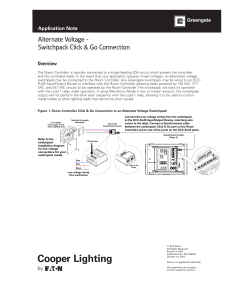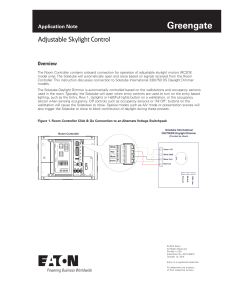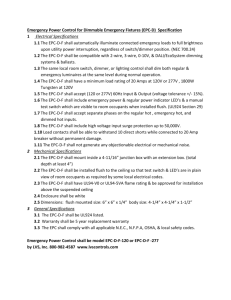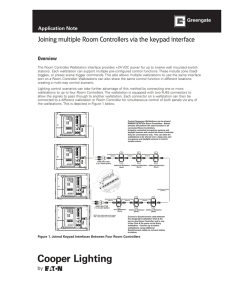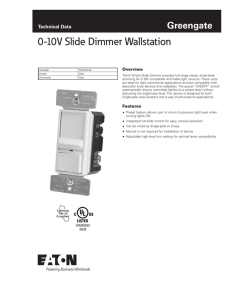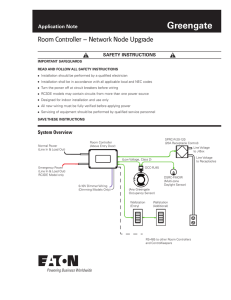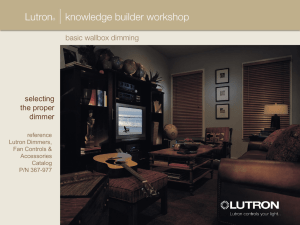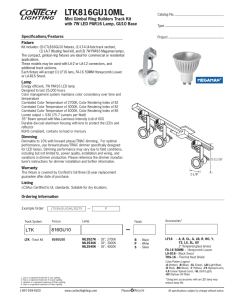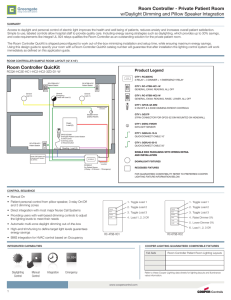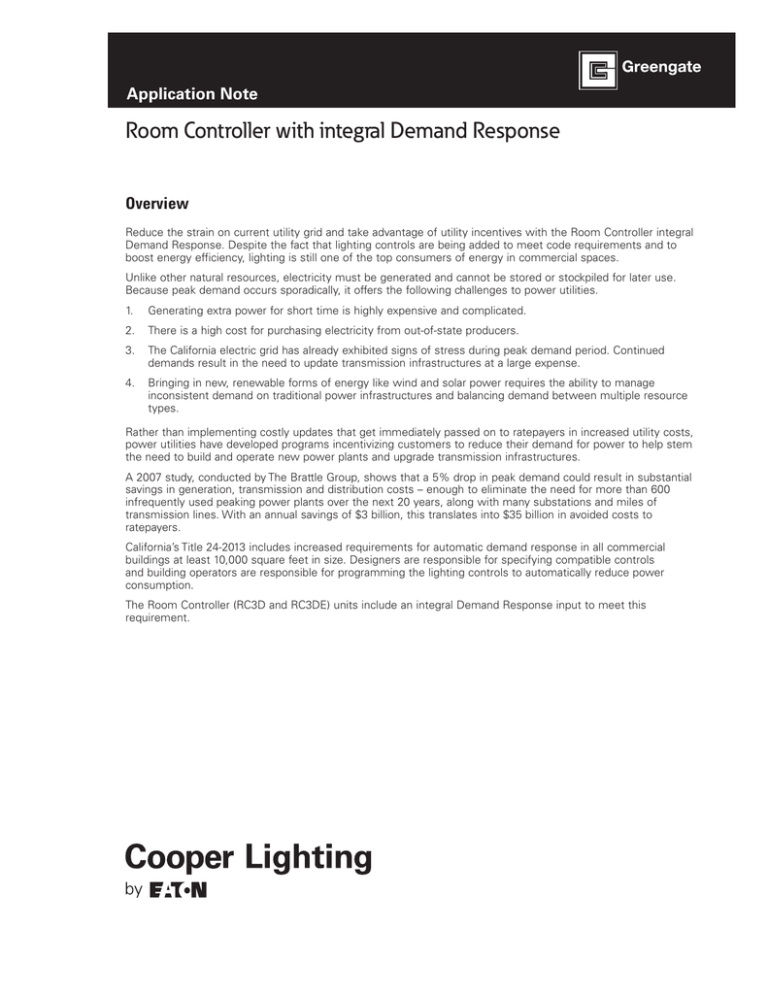
Application Note
INS #
Room Controller with integral Demand Response
Overview
Reduce the strain on current utility grid and take advantage of utility incentives with the Room Controller integral
Demand Response. Despite the fact that lighting controls are being added to meet code requirements and to
boost energy efficiency, lighting is still one of the top consumers of energy in commercial spaces.
Unlike other natural resources, electricity must be generated and cannot be stored or stockpiled for later use.
Because peak demand occurs sporadically, it offers the following challenges to power utilities.
1. Generating extra power for short time is highly expensive and complicated.
2. There is a high cost for purchasing electricity from out-of-state producers.
3. The California electric grid has already exhibited signs of stress during peak demand period. Continued
demands result in the need to update transmission infrastructures at a large expense.
4. Bringing in new, renewable forms of energy like wind and solar power requires the ability to manage
inconsistent demand on traditional power infrastructures and balancing demand between multiple resource
types.
Rather than implementing costly updates that get immediately passed on to ratepayers in increased utility costs,
power utilities have developed programs incentivizing customers to reduce their demand for power to help stem
the need to build and operate new power plants and upgrade transmission infrastructures.
A 2007 study, conducted by The Brattle Group, shows that a 5% drop in peak demand could result in substantial
savings in generation, transmission and distribution costs – enough to eliminate the need for more than 600
infrequently used peaking power plants over the next 20 years, along with many substations and miles of
transmission lines. With an annual savings of $3 billion, this translates into $35 billion in avoided costs to
ratepayers.
California’s Title 24-2013 includes increased requirements for automatic demand response in all commercial
buildings at least 10,000 square feet in size. Designers are responsible for specifying compatible controls
and building operators are responsible for programming the lighting controls to automatically reduce power
consumption.
The Room Controller (RC3D and RC3DE) units include an integral Demand Response input to meet this
requirement.
Technical Details
Adjustable Skylights
Switchpack
Receptacle
BMS/Out
Sensors
Sensors
Slider
Station
Wallstations
+
+
A/V
Mode
+
Demand
Response
+
Alert
Mode
Time
Clock
6
5
4
3
2
1
4
Reset
3
Energy
Options
Not Used
Occupancy
Occ
Vac (default)
0-10V Gain
Adjustment
Status
Low End
1 2
High End
Energy Options DIP Switch
Demand Response
Default 10%
20%
30%
40%
0-10V Dimming Outputs
+ + + Dimmer 3
Integration Controls
Green
Integration Controls
Black
QuickConnect Cables
Adjustable Skylights
Red
Integration Controls
Blue - Load In
Yellow - Load 1 Out
Blue - EM Line In
Blue - EM Loads Out
Black - Line In
White/Black - 120V N
White/Orange - 277V N
White
CAUTION: Bonding between conduit connections is not automatic and must be provided as part of the installation.
Red - Load 2 Out
Purple - Load 3 Out
The Greengate Room Controller (RC3D and RC3DE) integral Demand Response (DR) input allows a connection from a
Building Management System or Utility input device.
Dimmer 2
Dimmer 1
-
Dimmer 3
+
-
Dimmer 2
+
Time
Clock
+
+
+
A/V
Mode
+
A/V
Mode
Demand
Response
Alert
Mode
+
(Class 2)
-
Dimmer 1
+
Adjustable Skylights
Switchpack
Receptacle
BMS/Out
Sensors
Sensors
Slider
Station
Wallstations
+
+
A/V
Mode
+
Demand
Response
+
Alert
Mode
Time
Clock
6
5
4
3
2
1
4
Reset
3
Energy
Options
Not Used
Occupancy
Occ
Vac (default)
0-10V Gain
Adjustment
Status
Low End
1 2
High End
Energy Options DIP Switch
Demand Response
Default 10%
20%
30%
40%
0-10V Dimming Outputs
+ + + Dimmer 3
Integration Controls
Green
Integration Controls
Black
QuickConnect Cables
Adjustable Skylights
Red
Integration Controls
Blue - Load In
Yellow - Load 1 Out
Blue - EM Line In
Blue - EM Loads Out
Black - Line In
White/Black - 120V N
White/Orange - 277V N
White
CAUTION: Bonding between conduit connections is not automatic and must be provided as part of the installation.
Red - Load 2 Out
Purple - Load 3 Out
0-10V Dimming
Dimmer 2
Dimmer 1
-
Dimmer 3
+
-
Dimmer 2
+
Time
Clock
+
+
+
A/V
Mode
+
Demand
Response
Alert
Mode
(Class 2)
-
Dimmer 1
+
Adjustable Skylights
Switchpack
Receptacle
BMS/Out
Sensors
Sensors
Slider
Station
Wallstations
+
+
A/V
Mode
+
Demand
Response
+
Alert
Mode
Time
Clock
6
5
4
3
2
1
4
Reset
3
Energy
Options
Not Used
Occupancy
Occ
Vac (default)
0-10V Gain
Adjustment
Status
Low End
1 2
High End
Energy Options DIP Switch
Demand Response
Default 10%
20%
30%
40%
0-10V Dimming Outputs
+ + + Dimmer 3
Integration Controls
Green
Integration Controls
Black
QuickConnect Cables
Adjustable Skylights
Red
Integration Controls
Blue - Load In
Yellow - Load 1 Out
Black - Line In
White/Black - 120V N
White/Orange - 277V N
Blue - EM Line In
Blue - EM Loads Out
White
CAUTION: Bonding between conduit connections is not automatic and must be provided as part of the installation.
Red - Load 2 Out
Purple - Load 3 Out
0-10V Dimming
Dimmer 2
Dimmer 1
-
Dimmer 3
+
-
Dimmer 2
+
Demand
Response
Alert
Mode
Time
Clock
+
+
+
(Class 2)
-
Dimmer 1
+
0-10V Dimming
2
1
40% Demand
Response
2
1
1 2 3 4
30% Demand
Response
1 2 3 4
2
1
1 2 3 4
2
1
1 2 3 4
10% Demand
20% Demand
Response (Default) Response
Demand
Response
If using Demand Response, ensure the level of reduction is selected using Energy Option DIP Switches 1 & 2.
The Room Controller offers four energy consumption reduction levels (10%, 20%, 30%, 40%), set by using a simple DIP
Switch during installation. When a closure is detected on the DR input, all connected dimmable loads will gradually adjust to
the desired energy consumption reduction level. While in Demand Response Mode, occupancy detection, daylighting and
manual controls continue to operate normally within the reduced range.
2
Room Controller with integral Demand Responsewww.eaton.com
Once the DR input is cleared, lighting will remain at the current light level until a manual or daylighting command causes
the light level to be increased. This is done to reduce occupant distractions as well as increase energy efficiency and energy
savings.
Cooper Lighting
Fixture
DR Input
DR Energy
Reduction
Level
Conclusion
Demand Response requirements are necessary in today’s commercial building designs not only to meet current and future
energy codes but also to reduce stress on the power grid and reduce energy cost.
This need will continue to grow with future energy codes and power requirements. Utilizing the Room Controller (RC3D and
RC3DE) will ensure that Demand Response is an integral part of your design.
Eaton
1000 Eaton Boulevard
Cleveland, OH 44122
United States
Eaton.com
Eaton’s Cooper Controls Business
203 Cooper Circle
Peachtree City, GA
coopercontrol.com
© 2014 Eaton
All Rights Reserved
Printed in USA
Publication No. ACC140113
September 5, 2014
Eaton is a registered trademark.
All trademarks are property
of their respective owners.

